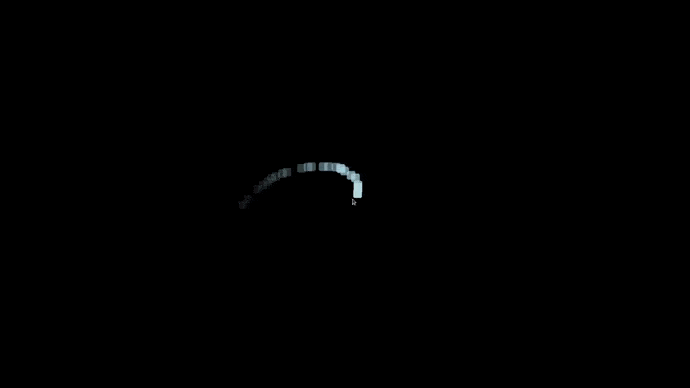Trail
Trail, Generates a trail behind HTMLElement and in HTMLCanvasElement.
look into the Change log for features and breaking changes
Content Outline
Introduction
Place the following <script> near the end of your pages, right before the closing </body> tag.
<script src="https://cdn.jsdelivr.net/npm/@dinoly/trail@0.4.2/dist/trail.min.js" crossorigin="anonymous"></script>After the above script, make a new trail object and pass in the class of the HTMLElement as a target parameter.
<script>
const move = new Trail({
target: "circle"
});
move.followMouse();
</script>Or create trails using Canvas, pass in the id of the HTMLCanvasElement as a area parameter.
<script>
const can = new CanvasTrail({
area: "canvas",
color: "#ffffff50",
effect: "line"
})
can.followMouse();
</script>HTML Trail
Sample code
<!-- index.html -->
<!DOCTYPE html>
<html lang="en" dir="ltr">
<head>
<meta charset="utf-8">
<title>Trail</title>
<link rel="stylesheet" href="./styles.css" /> <!-- Link to the style sheet with circle's custom styling -->
</head>
<body>
<div class="circle"></div>
<script src="https://cdn.jsdelivr.net/npm/@dinoly/trail@0.4.2/dist/trail.min.js" crossorigin="anonymous"></script>
<script>
const move = new Trail({
target: "circle",
});
move.followMouse();
</script>
</body>
</html>/* styles.css */
body {
margin: 0;
padding: 0;
background: black;
width: 100vw;
height: 100vh;
}
* {
cursor: none;
}
.circle {
background-color: lightblue;
width: 1.5rem;
height: 1.5rem;
border-radius: 50%;
pointer-events: none;
margin: 10px; /* will be removed */
}Arguments
{
target: null,
area: null,
particle: "default", // self
offset: ['default', 'default'], // 0px
delay: 50, // in milliseconds
color: "default", // white
isnode: true,
effect: "default", // straight
trails: false
}| Name | Description | code | types |
|---|---|---|---|
| target | Is the class of the HTMLElement behind which the trail will be generated. | target: "example" |
none |
| area | Is the class of the element inside which the trail will be generated. | area: "example" |
none |
| particle | Shape of the particle in trail, default: self. Additionally one can provide the particle style instead of pre-defined types
|
particle: "circle" or particle: "height:.3rem;width:.3rem; background-color:salmon;",
|
"circle", "triangle", "square" |
| offset | Offsets the trail from origin | color: "mediumseagreen" |
none |
| color | Color of the trail. Can be a gradient |
color: "#ffffff50" or color: [[0,"orange"], [30,"white"], [50, "green"]]
|
none |
| delay | Delay particle emission | delay: 1000 // 1s |
none |
| isnode | Set false if you want a trail for a Text or Svg, default: true
|
isnode:false |
none |
| effect | Behavior of the particle | effect:"spread" |
"spread", "rotate" |
| trails | If true will create trails with multiple particles, currently 2. |
trails:true |
none |
Note: if this trails:true creates a lag, use the effect: "spread" which will create similar effect with one particle.
Methods
| Name | Description | code |
|---|---|---|
| followMouse | Make the Html element follow the Mouse Pointer with a trail. | Trail.followMouse(); |
| followNode | Does not make the Html element follow the Mouse Pointer, add CSS to move the element how ever you like. | Trail.followNode(); |
| activeArea | make the Html element follow the Mouse Pointer when mouse hover a certain element, set with area: <class-of-area>
|
Trail.activeArea(); |
Canvas Trail
Canvas sample code
<!-- index.html -->
<!DOCTYPE html>
<html lang="en" dir="ltr">
<head>
<meta charset="utf-8">
<title>Trail</title>
<link rel="stylesheet" href="./styles.css" /> <!-- Link to the style sheet with circle's custom styling -->
</head>
<body>
<canvas id="canvas"></canvas>
<script src="https://cdn.jsdelivr.net/npm/@dinoly/trail@0.4.2/dist/trail.min.js" crossorigin="anonymous"></script>
<script>
const can = new CanvasTrail({
area: "canvas",
color: "#ffffff50",
effect: "paint"
})
can.followMouse();
</script>
</body>
</html>/* styles.css */
body {
margin: 0;
padding: 0;
background: black;
width: 100vw;
height: 100vh;
}
* {
cursor: none;
}
#canvas {
width: 100%;
height: 100%;
background: linear-gradient(#25364f, #4d71a5, #9bc4ff);
}Canvas Arguments
{
area: null,
color: "black",
effect: "default",
size: 5
}| Name | Description | code | types |
|---|---|---|---|
| area | Is the id of the HTMLCanvasElement inside which the trail will be generated. | area: "canvas" |
none |
| color | Color of the trail | color:"#ffffff50" |
none |
| particle | Behavior of the trail | particle:"paint" |
"default", "paint", "web", "line" |
| size | size of the particle, ranges between 1 to 9
|
size:"2" |
none |
Canvas Methods
| Name | Description | code |
|---|---|---|
| followMouse | Make the HTMLCanvasElement follow the Mouse Pointer with a trail. | CanvasTrail.followMouse(); |
Gifs
Bugs and Future Improvements
Improvements
- Resizing the trail.
- Trail behind multiple elements with one
Trailobject. - More Effects and Particles.
- Support for nested elements.







